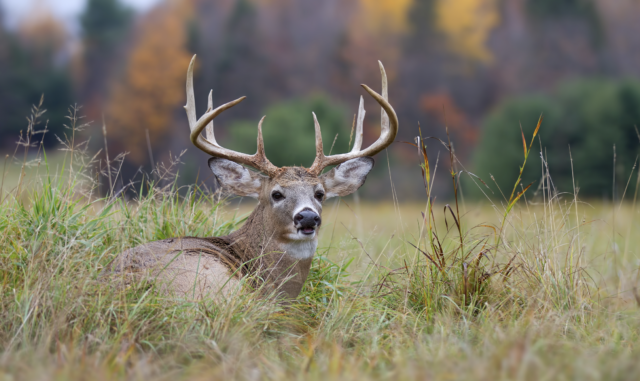by Evan Thomas
I, like many of you reading this article, counted down the days until the deer season opener with the excitement and enthusiasm that only a deer hunter can understand. Once season opened and hunting began, I counted down the days to the rut, which in my area is normally around mid-November until shortly after Thanksgiving.
By the first week of December, and many hours spent in a tree stand, a great many hunters have either filled their tags or given up. For those of us who are still trying to bag their buck, it isn’t too late. Late season bucks may require some changes in tactics, but they are still there and can still fulfill your dreams, fill your freezer, and earn a spot on your trophy wall. Think security and food supply to increase your odds of tagging your buck.
The big bucks that have made it this far into the season didn’t do it by being dumb or careless. They survived bow season, half of the rifle season, and the rut by being smart, stealthy, cautious, and maybe a little lucky.
After all the stress and strenuous activity of the rut, many mature bucks have lost twenty percent of their body weight or more. Late-season bucks are recovering from the strain and stress of all of the rut activity and trying to put on a few pounds before winter. Hungry they may be, but sitting over your protein and corn feeders, or turnip patch probably won’t leave you with a big buck to post on your Facebook page. Food and safety are the two things on the minds of the wall hangers right now. They certainly may visit your feed setup, but it won’t be during daylight hours. The daylight hours are spent bedded down in the safety of the thickest cover with the least activity available. The bedding areas are usually close to water and some type of food supply. They provide safety by offering cover and allowing the buck to hear, smell, or see danger before the threat can see the deer. Does will bed down with several others and have multiple sets of eyes, ears, and several noses to rely on for danger detection. Post-rut bucks will generally bed down alone and must rely on their own senses to detect danger. The mature buck’s bedding areas will usually be in the thickest, roughest cover you can find. Areas that are difficult to hunt, therefore have been avoided by other hunters. Locating these bedding areas without disrupting them is the difficult part. The good news is, once you do locate these buck bedrooms, they will use them every season as long as the habitat is not disturbed. Modern technology helps in this matter as cellular game cameras covering entry and exit trails to the suspected bedding areas will allow you to see what is entering the bedding area and what time of day the movement is occurring without the risk of disturbing the animals.
Your corn and protein feeders and food plots are still being used daily by does and smaller bucks. They are most likely getting a late-night visit from the old mature bucks, but probably aren’t being used as a primary food source this late in the season. The old mature bucks have many other stops they make each night. In the southern states, even after a few hard frosts, there is still a buffet of natural browse available for the old buck to graze on. There may still be some acorns that haven’t yet rotted. Water oaks often are the last to drop their acorns and continue dropping acorns very late into the deer season. If you locate such an area, this is your spot … Late evening hunts as the target bucks are just leaving the bedroom for their night on the move … the wind has layed, and everything is still … BINGO! If all the acorns are gone or rotten, look for Greenbriar. Greenbriar is a favorite browse for deer and will still have green leaves late in December. The height that the greenbriar leaves have been eaten is a good indicator of deer population and available food. The more deer you have, the higher up the vine you must go to find leaves. They will stand on their hind legs and eat as high as they can reach the leaves unless there is plenty at ground level. Nevertheless, find a good supply of Greenbriar in a wooded area and you have found a place to ambush a trophy buck going to or from his bedroom. Honeysuckle and dewberry are both abundant native plants that have green leaves deep into the winter. They are also favorite foods for deer and have been left alone by the masses, as the masses have been gorging on the easy stuff … your feed plots and feeders. Chinese privet thickets stay green late into winter in the climate of the southern states. If you have Chinese privet on your hunting property, late season is the time to hunt it. Not only do deer love it, but they also bed down in these thickets. Stealth is a must when hunting these locations because this may very well be the buck’s buffet and bedroom. Young dogwood trees and some varieties of wild plum will also stay green late into the winter in southern climates. These plum trees will grow in masses and cover an acre or more in some places. These native food sources are where the old timers fill their bellies post rut, leaving the feeders and food plots to the youngsters. Any of the above native food sources are a “home run” when searching for that late-season trophy.
Find the bedding areas. Find the food sources. Set up in between with the wind in your favor, and catch him going to feed just before dark or returning to bed at first light. Take advantage of modern technology to help determine which trails are most often used during legal shooting hours, and be ready to take the shot when it presents itself.
Just because the days of the deer season are numbered, it’s not over ‘til the fat lady sings. Don’t give up and throw in the towel just yet. Change your tactics, hunt smarter, and be patient. That’s the way to your late-season wall hanger and Facebook bragging.












